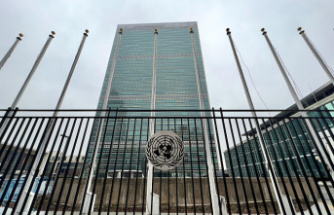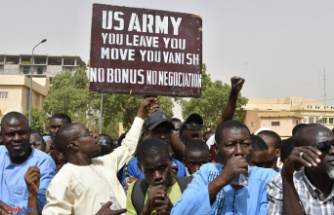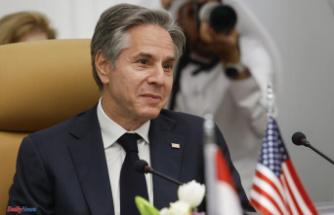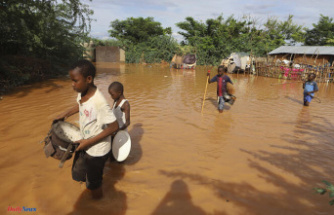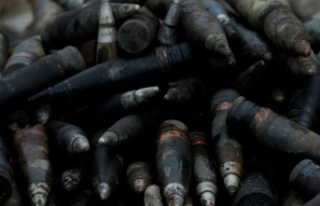Europe's largest nuclear power plant can be seen from the shore in Nikopol. Only a few kilometers of the Dnieper separate the Ukrainian-controlled city from the reactors, which can generate electricity for around four million households. Russian troops had already occupied the area at the beginning of the war. But never before has the situation in the contested region been as tense as it is these days.
The nuclear power plant was shelled at the weekend. While Kyiv and Moscow blame each other, the International Atomic Energy Agency (IAEA) is emphatically warning of a possible catastrophe. So far, no independent expert mission has been permitted on site. WELT answers the most important questions and explains why the situation also has military implications.
A warning from the Ukrainian government circulated thousands of times on Twitter on Monday. Accordingly, Russian troops had placed explosive traps in parts of the nuclear power plant in Zaporizhia. The Russian commander is said to have announced to soldiers that he would blow up the nuclear power plant under certain conditions. Either the area remains under Russian control or they leave "scorched earth" behind, the commander is quoted as saying. The information has not yet been independently verified.
According to Russian information, the nuclear power plant should continue to be in operation. Representatives of the military and the Russian nuclear supervisory authority are on site, the Interfax news agency quotes a Kremlin official in the region as saying. "We have the information from them that everything works in normal mode." This information cannot be verified either.
What is certain is that the nuclear power plant was shelled again at the weekend. According to the Ukrainian nuclear agency Energoatom, there was an impact near the spent fuel storage facility. It was also said that a block of the nuclear power plant had to be switched off temporarily after a high-voltage line was shelled. There was also a power outage in several areas of the region. However, the exact representations of both sides differ.
The Ukrainian operator accuses Russia of targeting the containers – and thus endangering its own troops. In contrast, Russia denies any responsibility for the shelling. "The shelling of the nuclear facility by Ukrainian forces is potentially extremely dangerous," a Kremlin spokesman said on Monday. He warned of possible "catastrophic consequences for a large area, including European territory."
The nuclear power plant had already been shelled before. In mid-July, Ukraine announced that it had successfully attacked military equipment and Russian soldiers on the site with a so-called kamikaze drone.
The nuclear power plant was built in Soviet times and was under the control of the Ukrainian operator until the Russian invasion. According to various reports, Ukrainian technicians are said to be on the site to this day. Wolfgang Raskob, an expert in nuclear safety research at the Karlsruhe Institute of Technology (KIT), said in an interview with WELT that the Zaporizhia nuclear power plant has so-called "containment" protection. "That means if a stray shell hits there, it shouldn't do any major damage. But if a big rocket hits, that's something completely different.” Then there would be problems in the reactor.
Raskob points out that, as in Fukushima, the possible loss of power supply is also a major risk. "If the external power supply is simply cut off because a grenade hits the mast, for example, then the only thing left is the emergency diesel to cool the reactor." Diesel is usually available for two days. Due to the Russian occupation, however, there is currently no information about the situation on site.
UN Secretary-General António Guterres said over the weekend that any attack on the nuclear power plant is "a suicide attack". IAEA chief Rafael Grossi said the situation was “completely out of control. He spoke of a currently "very real danger of a nuclear catastrophe that could threaten public health and the environment in Ukraine and beyond." Ukrainian Energoatom director Petro Kotin warned that the situation could lead to a "Fukushima or Chernobyl".
In concrete terms, the local population in particular would be threatened by a potential release. “There would be a zone of 50 to 100 kilometers in which it would no longer be possible to stay. Several 100 kilometers away, the environment would still be significantly contaminated,” says KIT researcher Raskob, who uses special systems to calculate daily the direction in which the wind will blow in the event of a release. "According to our calculations, less than 10 percent of the time the wind blows in a westerly direction, i.e. towards Germany," says Raskob. On many days, the wind is directed "full east towards Russia." In the event of a disaster, Russian areas would also be threatened.
Located in the south-east of the country, Zaporizhia is one of the areas where Ukraine is preparing for a major counter-offensive. For weeks they have been destroying Russian ammunition depots and supply lines in the south with American HIMARS multiple rocket launchers.
For the past few weeks, Russian troops have been setting up positions around the nuclear power plant and firing from them. There are also satellite images showing the Russians piling up heavy military equipment on the site. The Ukrainians have the problem that they can hardly react to it. Because every shelling can lead to a catastrophe. US Secretary of State Antony Blinken has accused the Russians of using the nuclear power plant as a "nuclear shield".



